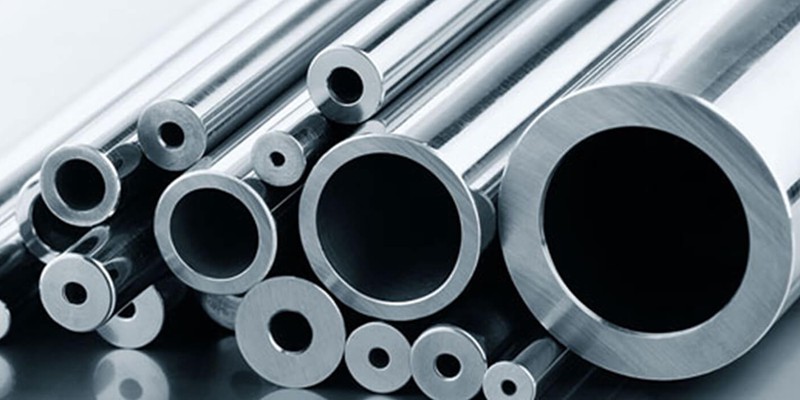- May 10, 2024
Heat treatment is a popular manufacturing process that enhances the quality of materials using controlled temperature exposure. Precipitation hardening is among the most common and utilitarian heat treatment processes, whose main purpose is to increase the yield strength and toughness of metal alloys.
In this article, we will discuss precipitation hardening in detail, the precipitation hardening process, which materials are commonly precipitation hardened, its benefits, and challenges.
What is Precipitation Hardening?
Let us begin with the main question of this discussion: What is precipitation hardening? In simple words, precipitation hardening, also called age hardening or particle hardening, is a heat treatment method that increases the strength of metal alloys.
It mainly works by forming precipitates of alloying materials/impurities, or secondary phase particles, inside the main lattice structure of the host material. These precipitates induce lattice distortions in the alloy’s crystalline structure, producing the characteristic precipitation-strengthening effect.
In short, age hardening is incredibly useful in enhancing the material properties of a large variety of alloys. It enables engineers to design high-endurance components within limited budgets and material availability.
How Does Precipitation Hardening Work?
The precipitation hardening process mainly comprises three steps, each of which requires a fine-controlled approach.
1. Preparation
The first step is to prepare the workpiece and the precipitation hardening equipment.
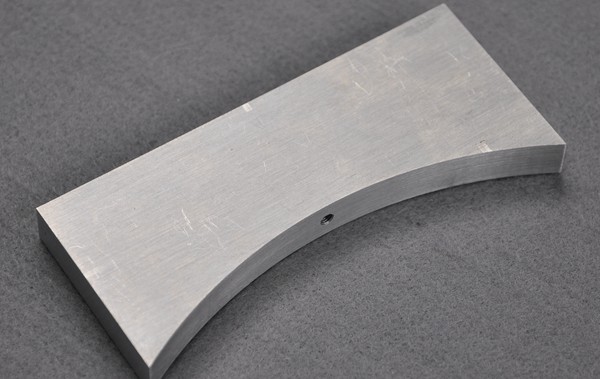
For the workpiece, there are some precautions that professionals take to ensure that the heat treatment is as efficient and cost-effective as possible. Complex, voluminous geometries are usually challenging as the heat does not spread throughout their body evenly, causing issues down the line. Therefore, the goal is to keep the geometry as simple as possible. This is not, however, always possible as most precipitation-hardening components are finished products like dies or tools.
In addition, the aging hardening equipment is usually a furnace that houses the workpiece during heating and keeps the heat at the required level. Generally, furnaces need to be prepared well in advance to achieve the correct temperatures and uniform heat distribution throughout the heating chamber. Thus, one of the important preparatory steps in age hardening is the cleaning, heating, and temperature control in the furnace.
2. Dissolution or Solution Treatment
This is where the real heat treatment begins. The goal of this whole activity, as we explained, is to make the alloy tougher by changing its microstructure. This cannot be done at room temperature as the microstructural components are immobile and fixed in their specific positions.
Therefore, the metal first needs to be brought into a state where the desired changes in its microstructure can be performed. In this step, the operators heat the alloy to a high temperature in a furnace. Typically, the heating temperature is just below the alloy’s melting point, or slightly above its recrystallization temperature.
At this temperature, the alloying elements, and any other impurities dissolve into the host metal to form a homogeneous solid solution. This is why this step is called solution treatment. It achieves an even, uniform distribution of alloying elements across the volume of the solid solution.
Now, this solution is ready for the next step in the age-hardening process.
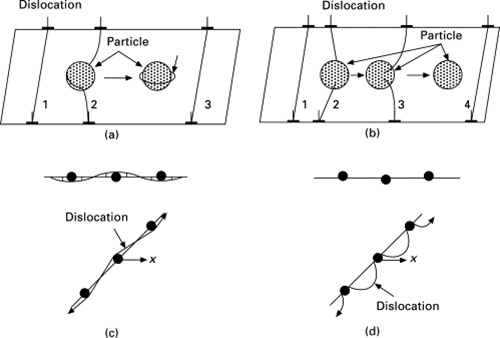
3. Quenching
The next step in the precipitation hardening process is quenching. At the end of the solution hardening phase, the alloying elements inside the host metal matrix are evenly distributed and all microstructure particles can easily move around in the matrix. The structure is highly ductile and flexible. This, of course, is not desirable in hard alloys.
Hence, in the quenching phase, this state of the solid solution is frozen in its place. To do this, the extremely hot, solid solution is rapidly cooled to room temperature in an appropriate quenching media like water or oil.
After quenching, all microstructural particles get fixed in whatever position they are in, preserving the uniformity of the solid solution but also eliminating the ductility of the high-temperature solution. In this frozen state, the movement of the microstructure is extremely restricted as particles are locked in place.
4. Precipitation
The final step in precipitation heat treatment is precipitation or aging. After quenching, the operators reheat the alloy to a lower temperature and maintain it there for an extended period. This is where the name ‘aging’ comes from, as it takes time.
The aging temperature depends on the alloying metal, but it is typically within the range of 150℃ – 550℃. The aging duration is typically in the order of a few hours.
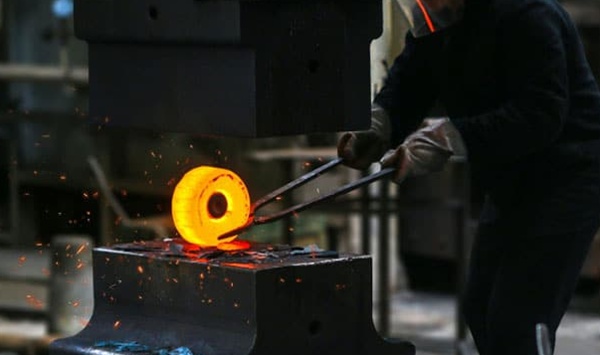
During aging, the alloying elements in the solid solution mix to form small, finely dispersed clusters inside the matrix. These clusters, or precipitates as we call them here, cause particle hardening, acting as barriers to the movement of dislocations in the lattice matrix, and hindering plastic deformations. This increases the material’s hardness and strength.
It is very important to control the temperature and aging duration at this step. It has a direct effect on the size, distribution, and composition of precipitates, which in turn influences the quality of the precipitation-hardened alloy.
After the intended precipitation is achieved, the alloy is slowly brought back to room temperature, after which it is ready to use.
What Materials are Commonly Subjected to Precipitation Hardening Process?
Precipitation heat treatment applies to a huge variety of metal alloys. The most common ones are age-hardening aluminum (2024, 6061 and 7075), precipitation hardening stainless steel (17-4 PH, 15-5 PH), titanium alloys, and magnesium alloys.
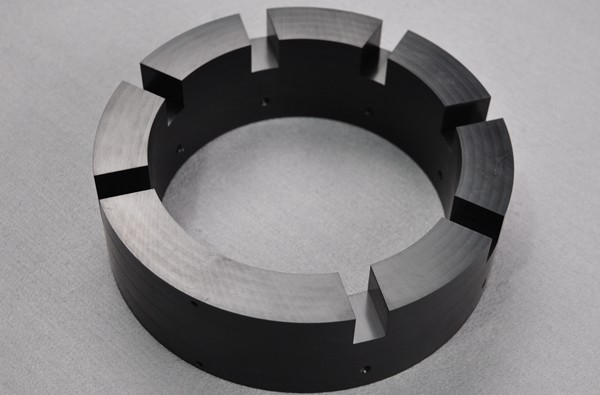
Age hardening is not limited to conventional metals but also extends to superalloys. Nickel-based superalloys like Inconel 718, Waspaloy, and René 41 are also compatible with precipitation heat treatment.
Overall, the range of age-hardening alloys is quite diverse and gives engineers a lot of flexibility in their work. For example, precipitation-hardened stainless steel elevates the yield strength of the material, offering a unique mix of material properties including high strength, corrosion resistance, and appearance.
Benefits of Precipitation Hardening
Precipitation-hardened materials boast numerous favorable material properties that make them better than their untreated versions. This section summarizes the main benefits of particle hardening.
Increased Strength
The most advantageous benefit of precipitation hardening is the increase in yield strength. As discussed, this is due to particle hardening preventing dislocation movement and inducing extra plasticity into the alloy.
To put things into perspective, Aluminum 6061 is a popular candidate for age-hardening aluminum. The T6 age hardening temper increases the yield strength of this alloy from 124 MPa to 276 MPa, more than twice its original value. This underpins the importance of precipitation strengthening in improving a material’s strength.
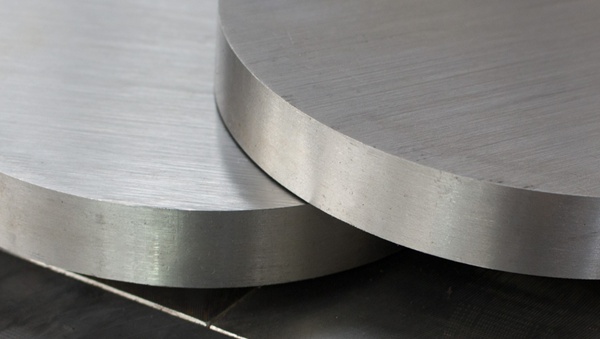
Toughness
Toughness is another favorable property that can increase due to age hardening. It releases internal stresses in the material and achieves a more uniform microstructure, increasing its resistance to impact loading and stress-induced fractures, furthering its contributions to structural integrity in engineering designs.
Let us consider Aluminum 6061 again. Its ultimate tensile strength increases from 117 MPa to 310 MPa for the T6 heat treatment, signifying the impact of precipitation hardening.
Hardness
Hardness is another important property that is enhanced during the precipitation hardening process. As before, this is a product of increased resistance to dislocations within the alloy matrix.
For example, we can take the example of a die-casting process. The dies must be strong, hard, and very durable so they can withstand thousands of production cycles. To achieve this, producers use precipitation-hardened steel or aluminum dies, which have a longer life and greater value for mass production.
Dimensional Stability
The improvement in strength and toughness also accompanies an improvement in the dimensional stability of the alloy. The material becomes slightly more resistant to thermal deformations and plastic deformations, leading to a higher capability to retain its shape under mechanical and thermal loads.
This is a very desirable quality from an engineering point of view. After precipitation hardening, parts do not readily deform during intensive production processes like machining and metal polishing, preserving their shape.
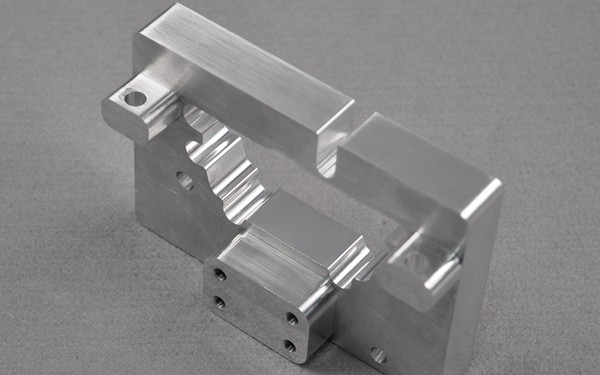
Cost Effectiveness
Precipitation heat treatment also leads to lesser production costs. The improvement in mechanical properties often outweighs the additional cost of heat treatment by eliminating the need to invest in a costly alloy with the same properties.
For example, the properties you get in precipitation-hardening stainless steel may be at par with high-strength materials and you save the cost of buying expensive titanium alloys.
Challenges and Tips for Precipitation Hardening Treatment
Precipitation hardening is not without its fair share of challenges, with the precision control requirements and intricate mechanisms dictating its success. The following sections will highlight some of the main challenges and tips for age hardening.
Challenges of Precipitation Hardening
Here are three main challenges in the precipitate process.
Precipitate Homogeneity
Achieving uniform precipitate size and distribution is crucial for successful age hardening but can be challenging. Problems like these occur when heat is unevenly supplied to the material or when quenching is not efficient enough to freeze all portions of the material’s volume uniformly. Especially it is harder in large and complex parts.
Over-Aging
Over-aging is a common problem in precipitation heat treatment. It happens when the material is aged at very high temperatures or for too long, causing the precipitates to be coarse. Consequently, there is a reduction in strength.
Residual Stresses
A negative side effect of rapid cooling during quenching and then thermal expansion during aging is the introduction of residual stresses in the material. This can cause dimensional distortion, cracking, and uneven properties. Engineers can tackle this by minimizing thermal gradients during heating and cooling cycles and employing stress-relieving treatments like cold compression.
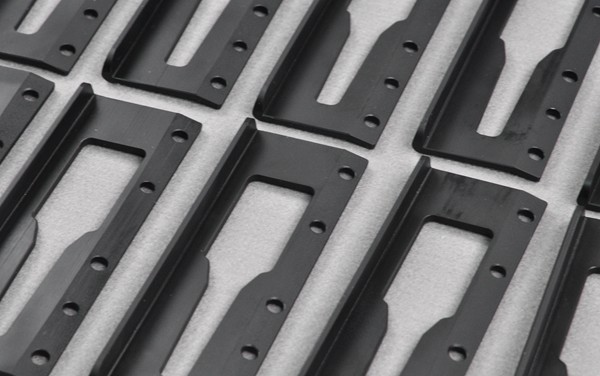
Tips for Precipitation Hardening
You can follow these tips to ensure the precipitation treatment to perform well.
Optimize Heat Treatment Parameters
Numerous parameters like temperatures, time, and heating/cooling rates govern the success of the precipitation hardening process. Developing an understanding of how these parameters affect the result, and optimizing their selection accordingly is a great way of ensuring maximum results.
For example, using a poor cooling medium for quenching can slow down the cooling rate, which causes larger than required precipitates to form within the alloy matrix, negatively impacting its hardness and toughness. This level of proficiency, however, comes with some experimentation and experience, so employing appropriate testing methods and giving yourself time to learn is necessary.
Precise Temperature Control
Maintaining the correct temperature during precipitation strengthening is crucial for a successful heat treatment process. For example, the general guideline for the solution and aging temperatures for aluminum 6061 are 529oC and 160oC, respectively. To maximize heat treatment efficiency, operators should remain within a close range of these temperature target values.
Quality Testing
Tracking process performance through quality testing is a great way of getting feedback on how well your heat treatment plant is working. Some of the tests engineers use for in-process quality testing include non-destructive testing and hardness testing to measure failure propensity and material properties.
Precipitation Hardening vs Annealing and Quenching
Heat treatment is a very versatile concept, with several kinds of processes falling under its umbrella. Precipitation hardening, annealing, and quenching and arguably the most common of these. Naturally, there is bound to be some confusion between these processes since all three of them include temperature exposures to alloys for specific periods.
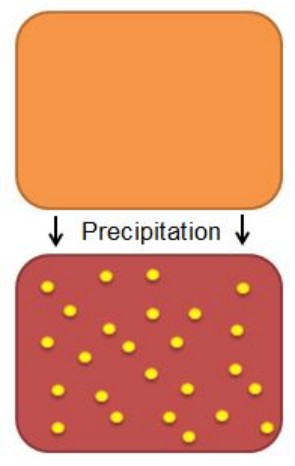
Precipitation Hardening vs Annealing
Annealing is primarily a stress-relieving process that improves the material’s ductility and machinability. This is in contrast to age hardening, whose primary purpose is to make a material stronger and harder.
The start of both processes is similar, though. The furnace raises the temperature of the allow to a point around its recrystallization temperature. However, after this, the steps of both processes differ.
In precipitation hardening, the hot, solid solution goes through rapid cooling (quenching) in the next step. However, in annealing, the heated alloy is allowed to cool down at a much slower, controlled rate in a less severe cooling media like still air.
Precipitation Hardening vs Quenching
Quenching has already been mentioned in this discussion before as it is also a sub-process in the precipitation hardening procedure.
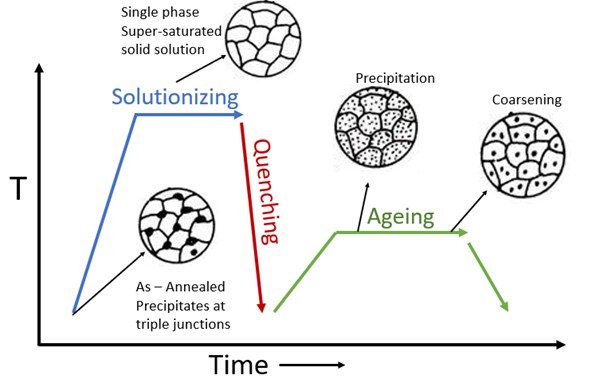
In quenching, the material is heated up to a high temperature and then very rapidly cooled down to room temperature, causing its microstructure to freeze in its current state. This induces hardness and brittleness in the material.
This is fundamentally different from precipitation hardening. In precipitation hardening, the material is heated, quenched, and then reheated to form hardening precipitates. Therefore, it has more steps than a simple quenching process.
Applications of Precipitation Hardening Process
Precipitation hardening has innumerable applications in a very diverse range of industries. We will highlight some of its core applications below.
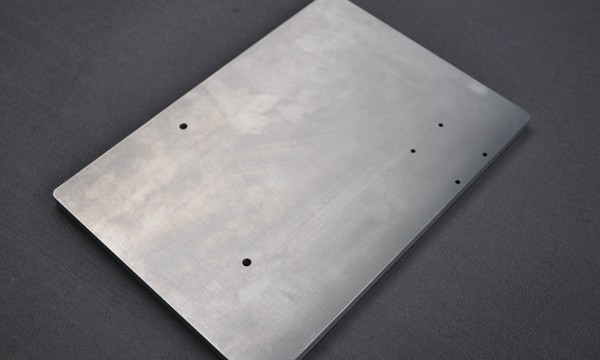
- Aerospace: Precipitation-hardened alloys are very common in manufacturing aircraft structural components like landing gear, engine components, fasteners, etc. For instance, Al-6061 T6 is known as space grade, owing to its aerospace applications.
- Automotive: Automotive components like engine parts, suspension components, and chassis parts go through age-hardening processes for additional strength and durability.
- Medical: A variety of implant and surgical instrument manufacturers prefer precipitation-hardened alloys because of their hardness and durability.
- Tooling: Cutting tools for machining are often made from precipitation alloys due to their added strength and wear resistance.
Conclusion
Precipitation hardening is inarguably among the most useful heat treatment processes in manufacturing. It offers incredible results in the form of improved strength, hardness, and dimensional stability.
WayKen offers comprehensive machining services for various industries, including CNC metal machining, vacuum casting, 3d printing, and rapid tooling. We also provide a wide range of metal alloys, including precipitation-hardened grades. to meet your specific requirements.
Our team of experts, professional skills, and one-on-one engineering support to serve you in every aspect of your product development projects. From order to final delivery, WayKen commits to achieving your project with high quality and reliability. Discover what exactly our custom machining services can do for you – contact us today to discuss your project requirements.
FAQs
How does the choice of aging temperature and time affect the properties of precipitation-hardened alloys?
Aging temperature and duration are critical for achieving the desired results. Higher temperatures or longer exposures can make coarser precipitates, diminishing the positive effects of age hardening.
What are the main challenges in achieving uniform precipitation throughout a complex-shaped part?
When part geometry is complex, achieving uniform properties is challenging. Strategies like controlled cooling and heat treatment fixtures can get the job done.
How does the quenching medium influence the properties of a precipitation-hardened alloy?
The choice of quenching medium (water, oil, polymer solution, etc.) can affect the cooling rate during quenching and the resultant microstructure of the material. Different quenching rates can cause variations in hardness, strength, and residual stresses, which can negatively impact part quality.

